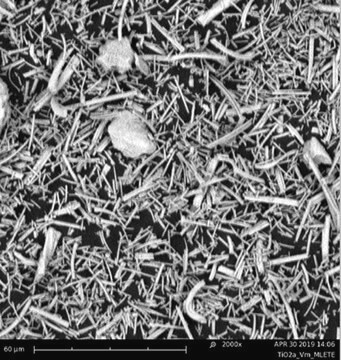799289
Titanium dioxide
nanotubes, 25 nm average diameter, powder
Synonyme(s) :
Titania nanotubes, Titanium oxide nanopowder
About This Item
Produits recommandés
Forme
nanotubes
powder
Niveau de qualité
Diamètre moyen
25 nm
pb
2972 °C
Pf
1843 °C
Application(s)
battery manufacturing
Chaîne SMILES
[Ti](=O)=O
InChI
1S/2O.Ti
Clé InChI
GWEVSGVZZGPLCZ-UHFFFAOYSA-N
Catégories apparentées
Application
Code de la classe de stockage
13 - Non Combustible Solids
Classe de danger pour l'eau (WGK)
nwg
Point d'éclair (°F)
Not applicable
Point d'éclair (°C)
Not applicable
Faites votre choix parmi les versions les plus récentes :
Déjà en possession de ce produit ?
Retrouvez la documentation relative aux produits que vous avez récemment achetés dans la Bibliothèque de documents.
Les clients ont également consulté
Articles
Electronically, it behaves as a wide band gap (3.2 eV) semiconductor and exhibits memristor properties.2 Optically, TiO2 has high opacity with a very high refractive index3 (>2.4), and it exhibits strong absorbance in the UV range.
The production of hydrogen by catalytic water splitting is important for a wide range of industries including renewable energy petroleum refining and for the production of methanol and ammonia in the chemical industry.
The past several decades have seen major advancements in the synthesis of metal nanomaterials. Most recently, controlled synthesis has become versatile enough to regulate the exact number of atoms and ligands of very small metal nanoparticles, referred to as “clusters”.
Next generation solar cells have the potential to achieve conversion efficiencies beyond the Shockley-Queisser (S-Q) limit while also significantly lowering production costs.
Global Trade Item Number
| Référence | GTIN |
|---|---|
| 799289-500MG | 4061832974026 |
Notre équipe de scientifiques dispose d'une expérience dans tous les secteurs de la recherche, notamment en sciences de la vie, science des matériaux, synthèse chimique, chromatographie, analyse et dans de nombreux autres domaines..
Contacter notre Service technique
